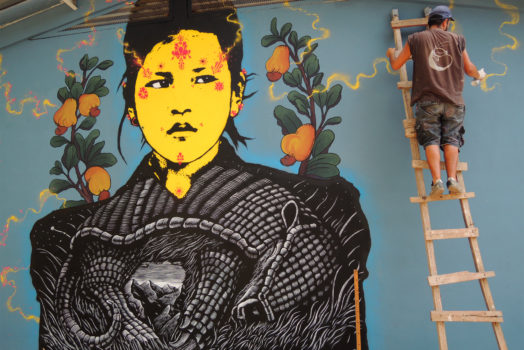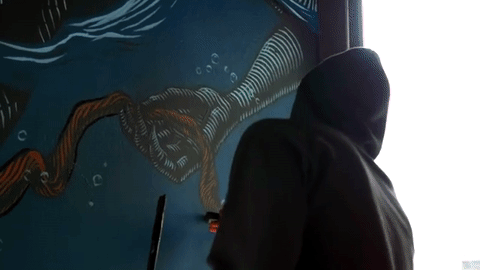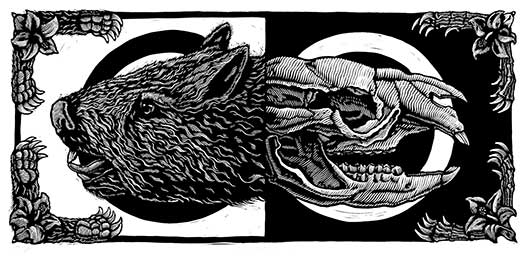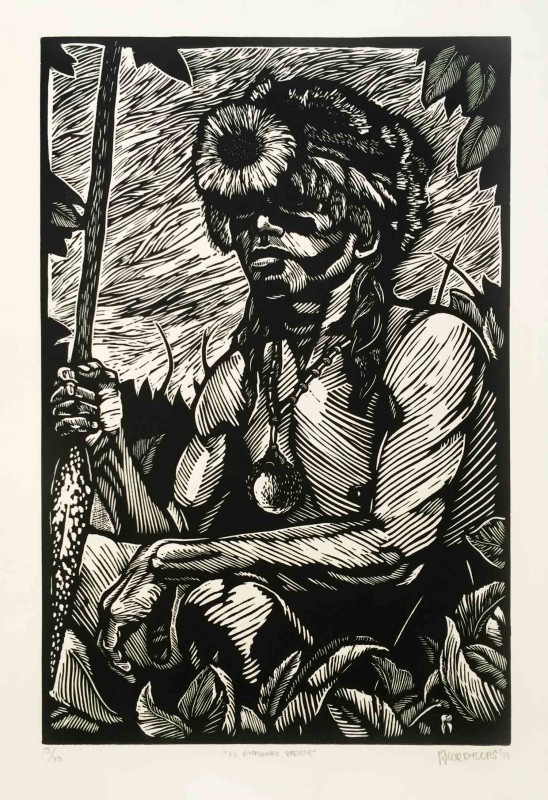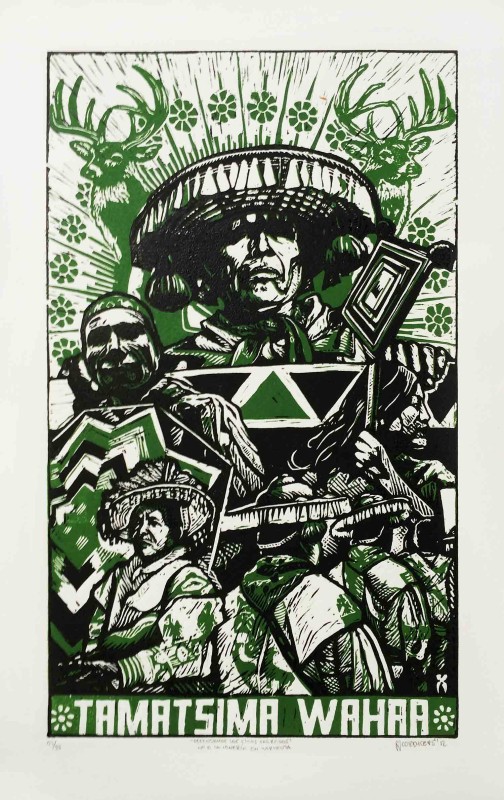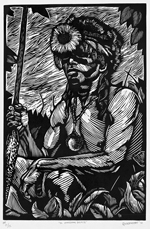
Mazatl is an artist residing in Mexico City. His works embody a striving for justice and a sense of hope. HIs answers to our five questions reflect a rare mixture of compassion and intellectual bravery.
Visit his Justseeds page here, and his 555 gallery here.
555c: What led you to art, in particular your particular medium and style?
Mazatl: Mexico has a long tradition of printmaking and relief printing, particularly using art and printing as a way to address the problems and the injustice that we face collectively. Since I was a kid, I remember being exposed to imagery with social and political commentary, images in magazines, schoolbooks, flags and posters that were so intricately created and shaded. I would sit there and stare at them for hours trying to figure out how in the hell you got those black lines to look like that. I’d sit and try to mimic them but it wasn’t until years later that I got exposed to relief printing that I understood what it is to carve out the white of the image.
I think that those powerful black and white images became deeply imprinted in me. As I got older I became acquainted with some of the artists work like Jose Guadalupe Posada, Manuel Manilla, Taller de Grafica Popular (TGP), the ‘68 movements graphics, the Escuela de Cultura Popular Martires del 68 (ECPM68) and others. I understood the effectiveness of the strong tradition of the synthesized black and white images along with a dignified demand for justice, land and freedom.
I think that even though a majority of these prints and posters are dealing with some serious and heavy shit, they are still able to do it humorously and graciously. They use a language that appeals to everyone, not just some educated elite that “knows” and “understands” how to appreciate art. The fact that some of these artists decided to remain anonymous, and that did all they could to benefit the collective wellbeing gave me a direction to pick up from where they left off. I think that artists and graphic creators are by no means the authors of their pieces. They just merely materialize ideas created collectively, images that exist already. We simply translate them, but that’s only one small part of the work.
555c: Does evil exist as an entity, or is it something invented by humanity?
Mazatl: I don’t believe that evil exists as a separate entity. I think that there is a potential in all of humans and non-humans alike to do things that might be harmful to others. However, the conception is based on a set of morals or rules that would determine whether or not our act is beneficial or harmful. Similar to the concept of violence, physical violence is everywhere around us. Especially if we live in cities, we are exposed to violence 24/7. But there are sets of morals that help us cope with our existence in this day and age, but of course, the media and the powers that be manipulate those conceptions. For example, if we take what people define as “terrorism” in the USA, and military invasion and occupation, both use very similar tactics of violence, but there might be differing opinions based on where you come from and what your position is. People, institutions and corporations throw around definitions that shape our view of evil and violence.
Here in the Americas there have been massacres since Columbus set foot here, and they are still very much happening to this day. Indigenous people, people of color, poor people, and whole ecosystems are still being wiped out for resources that we use in cities: water, power, minerals, forest, dams– you name it.
These massacres are invisiblized. Can you imagine what would happen if people knew and were well aware that there are whole communities getting wiped out just a few kilometers away? Well now imagine what happens thousands of miles away.
Naturally I don’t think that you’re evil if you use power from a coal-fired power plant; or from a dam that has displaced whole communities; or if you’ve bought a gold or diamond ring, but there is violence that comes with those things. This economic system is violent. It teaches us to be selfish, to only worry about ourselves and maybe if we’re are lucky, our families. While we turn our blind side to these problems and fill our lives with commodities, we contribute to keep this system that devours people, animals and ecosystems. But then again is it evil? Is it ignorance? Apathy? Selfishness? That’s exactly what the system is teaching you and your children. So who’s really evil?
555c: What do you think happens after we die – what would you like to happen?

Mazatl: Judeo-Christian morals teach that there’s a better life after this one, therefore we are able to mentally and physically endure the inequities imposed on us by other human beings. Even though Mexico is an extremely Catholic country, it has been able to keep some of our indigenous roots and while simultaneously believing in mainstream culture and religion. Often times we are exposed to a combination of indigenous religious, and spiritual beliefs mixed with those imposed by colonizers. I personally believe that everything around us is energy and that this energy binds us to one another, to our ecosystems, to plants, to animals, to the elements and the earth.
Even from a scientific point of view, all energy shifts forms constantly, and that energy can be seen shifting in the cycles of life. We all go back to the earth. No matter how rich or talented we are in life, we will all surrender our energy to be shifted. The energy of our bodies will shift to feed the soil that fed us and supported us in our lifetimes.
I don’t think I would want more than that, just to let my borrowed energy be returned to where it came from, because it never really was separated.
555c: What is the biggest challenge/obstacle facing human progress/evolution today?
Mazatl: I’m not sure what the biggest challenge is since the list is so long. But a big one was implied in the question. The conception that we should progress into something else other than being part of our ecosystems has put us in a extremely difficult place. This conception that “civilized” humanity should rise above everyone and everything else is extremely problematic. It has left the human and non-human world deeply imperiled. This conception is defined as anthropocentrism and is pushed forward by most mainstream cultures and religions, by science, and especially by the capitalist economic system.
Along with anthropocentrism come notions of inequality amongst races, gender, class, religious believes, discrimination and totalitarianism.
I think the world is constantly evolving, but any effort to progress at the cost of others in my eyes is no solution to any of the problems we face. Not one person will be free until we are all free.

arm3555c: Who are some active artists that the public needs to know more about?
Mazatl: There are millions of people out there doing what they can to construct collective autonomy, by organizing, building community, connecting to each other through media and autonomous forms of communication, networking, printing, painting, sweeping floors, setting up events, playing music, chopping wood, building spaces, speaking, etc… All of these activities and talents are just as much art production as any master painter or printer.
There are thousands of Indigenous communities scattered all across the globe whose lives and livelihoods are examples to construct a better reality. Lots of these communities are being wiped out, massacred and exterminated because their very existence threatens the interests of the economic system and its culture. Resistance and survival in the face of genocide is a work of art. The knowledge that these communities hold is invaluable and might help resolve many of the problems we all face. Support these communities, learn about them.
I’m part of a number of groups seeking social/environmental/political justice, for more info visit: justseeds.org or if you’re in Mexico City visit the ECPM68.
